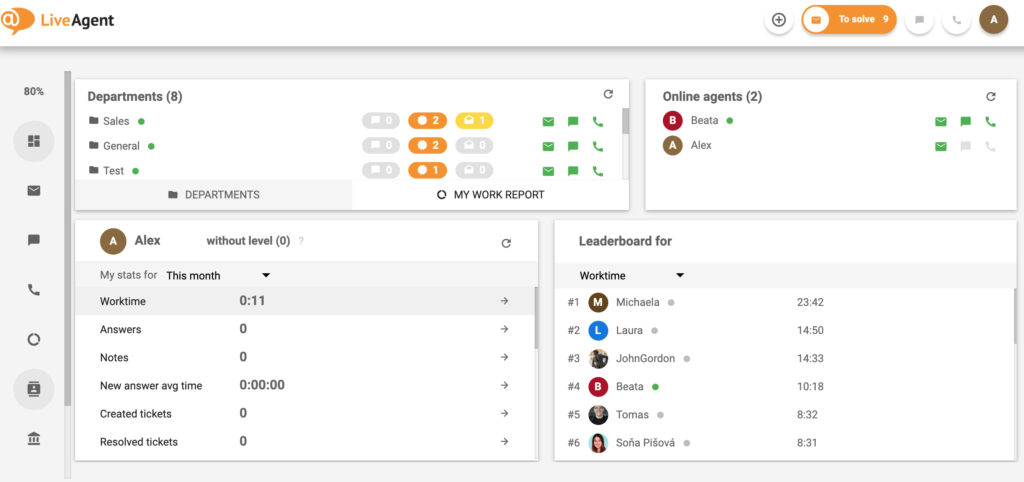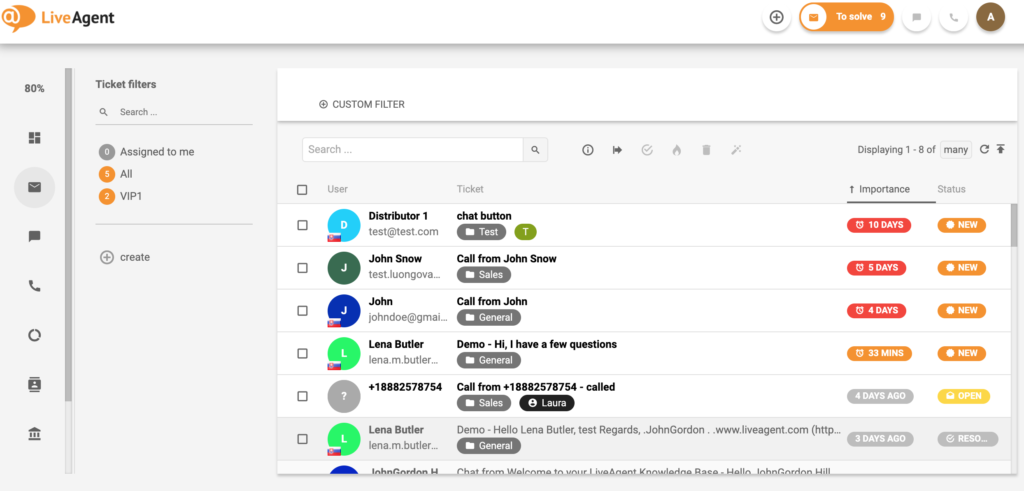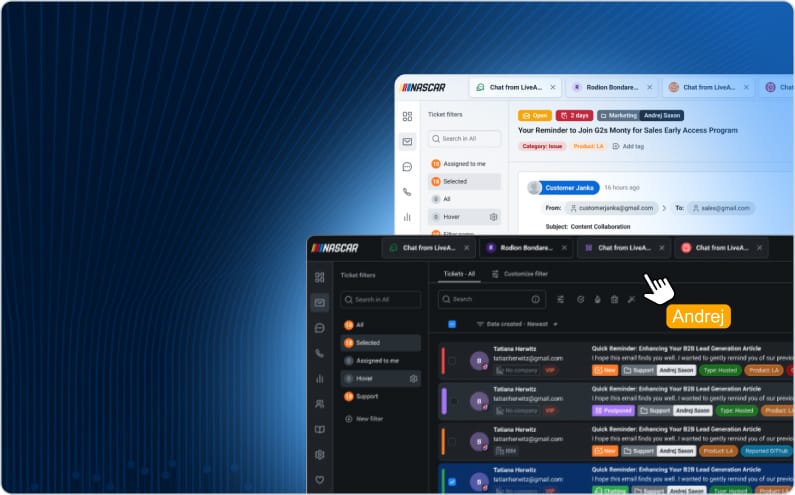When it comes down to operating a customer support team – time matters. Even if your customer support department consists of just two people – it still has to be managed, right? Your company’s relations with customers are way too important to waste time away.
However, how does one know how many customer support representatives the company needs? If your whole team is somewhere around 25-30 people then the solution is quite simple – whenever you see that your agents are overloaded, you hire new ones. But what if your team is much bigger? In this case, there are a few metrics that you have to keep in mind while figuring out the number of your agents. It’s the monthly number of tickets, how many customers you have, and your incident rate. Keep in mind that these three are the most important, but definitely not the only metrics you will be using. The more specified your calculations will be, the more effective your customer support team will work.
In-house customer support team: Why and when you need it
The in-house customer support team is indeed a good option to consider when setting up your customer service department. “In-house” means that the support agents will be working in the same building as you do, therefore you might have better control over their performance. What is so appealing about internal teams though? Let’s quickly get through their pros and cons.
In-house pros and cons
Pros:
- Excellent product knowledge. In-house teams are usually located in the very “heart” of the product development, therefore agents are far more familiar with all nuances.
- Faster feedback. Due to the convenient location of your team, you will receive all the customer’s feedback immediately.
- Better control over the communication process between your customers and support agents.
Cons:
- The price. Having an in-house team can be pretty pricey, as you will have to pay the rent for the office and many other overheads, including taxes.
- To provide 24/7 support you will require more agents, some of them will have to work during night shifts (which brings us back to the cost-effectiveness matter).
The in-house customer support team is also a great idea when you are launching an unusual product that might require extra attention.
Outsource customer support team: Your second option to consider
Even though having an in-house customer support team sounds very appealing and convenient for a business, more and more companies turn to outsource practices these days. In the IT industry, “outsourcing” certain tasks means delegating them to an outer contractor (be it a company or a freelancer) that is usually more cost-effective and has more experience in doing a particular task. This way you get the job done and free yourself some time for more urgent things. Not to mention that outsourcing can also save you lots of resources, as it allows you to hire specialists from all around the globe.
So how could an outsourced solution be a good fit for your business? Well, it solely depends on the type of product or service you have to offer. It is often the case that companies, who produce consumer products tend to outsource their customer support team. However, a lot of SaaS, Software, Fintech, Gaming, and other IT companies choose to outsource. Why? Let’s take a closer look at the outsourcing pros and cons of the customer support team.
Outsourcing pros and cons
Outsourcing pros:
- It’s cost-effective. In the case of outsourcing, one can choose among hundreds of options all around the world, therefore choosing the solution that fits the best.
- Faster employment. If you decide to stick with an in-house service team, you will need to deal with lots of bureaucracy and onboarding process. Outsourced customer service allows you to avoid that and get straight to the point.
- Easier replacement. Sometimes situations occur when you for some reason need to shorten or expand your team. While outsourcing it, you will not lose resources over such decisions as all team members are usually easy to replace.
Outsourcing cons:
- There could be difficulties in communication. Since your outsourced customer service team can be located in any corner of the world, some language and cultural barriers might occur.
- Security risks. When the person-to-person communication gets replaced with an online one, data security breaches might take place. Of course, it greatly depends on your contractor, so be careful when looking for your outsourcing company. Providers must invest in their cybersecurity and conduct audits on a yearly basis.
Final thoughts
Both these options have their in-house, and outsourcing pros and cons. Instead of comparing them to each other, you must focus on your project needs, your budget, and the type of your product. Eventually, these are the things that must determine your choice of customer support representative team.
Discover on your own
Knowledge is important, but only when put into practice. Test everything in our academy right inside the LiveAgent. LiveAgent is a Customer Service Software that helps your agents improve and support your customers efficiently and effectively.
If you would like to learn more, read LiveAgent – Features.


Try out LiveAgent for FREE
Handle all customer inquiries from one interface. Start improving your customer service with a 30-day free trial right away!
Frequently Asked Questions
What are the benefits of outsourcing a call center?
Outsourcing a call center can offer several benefits. For example, it can lead to cost savings for companies, as it can be more affordable to hire call center agents in regions with lower labor costs. It also provides access to a larger talent pool of potential employees, allowing companies to find agents with specific language skills or expertise. Other notable benefits include flexibility, scalability, and the ability to provide 24/7 customer service.
What is the risk of outsourcing call center?
While outsourcing can offer flexibility and scalability to businesses, it also comes with certain risks. If the outsourced call center fails to meet the standards of service as an in-house team, it can result in damage to the company's reputation. Another risk is the loss of control over the customer experience. When customer support operations are outsourced, the business may have less influence on how its customers are being handled. Other risks include language barriers, or data security and privacy concerns.
What is in-house customer service?
In-house means that the support agents will be working in the same building as you do. Therefore, you might have better control over their performance.
Why should you consider an in-house customer support team?
The pros of the in-house customer support team are excellent product knowledge, faster feedback, and better control over the communication process.
Is an outsourced customer support team right for your company?
Well, it solely depends on the type of product or service you have to offer. It is often the case that companies who produce consumer products tend to outsource their customer support team.
How do I build an outsourced call center?
Building an outsourced call center entails selecting the location and size, based on call volume, language requirements, and cost. Choose an outsourcing partner with a good reputation, relevant experience, and capability to meet specific needs. Establish clear communication channels and performance metrics. Provide adequate training for staff to represent your brand effectively and excellent customer service. Consistently communicate and monitor the center's performance for success. It requires careful planning and management to align with business goals.
Discover the advantages of a hosted call center with LiveAgent: enhance customer satisfaction, expedite response times, and reduce costs. Our web-based solution offers features like inbound/outbound calling, IVR, call queuing, video calls, and more, ensuring efficient and flexible customer support. Start your free trial today and transform your customer service experience!
On-site vs Remote customer service
70% of global workforce works remotely at least once a week, iwg finds. On-site team can be crucial for making a new product great.

 Български
Български  Čeština
Čeština  Dansk
Dansk  Deutsch
Deutsch  Eesti
Eesti  Español
Español  Français
Français  Ελληνικα
Ελληνικα  Hrvatski
Hrvatski  Italiano
Italiano  Latviešu
Latviešu  Lietuviškai
Lietuviškai  Magyar
Magyar  Nederlands
Nederlands  Norsk bokmål
Norsk bokmål  Polski
Polski  Română
Română  Русский
Русский  Slovenčina
Slovenčina  Slovenščina
Slovenščina  简体中文
简体中文  Tagalog
Tagalog  Tiếng Việt
Tiếng Việt  العربية
العربية  Português
Português 









